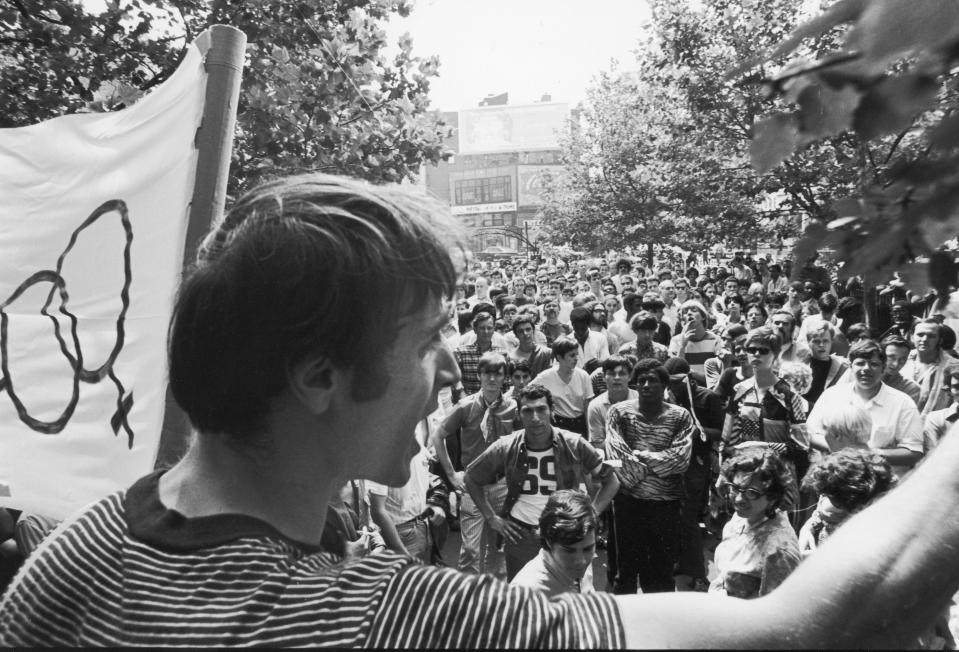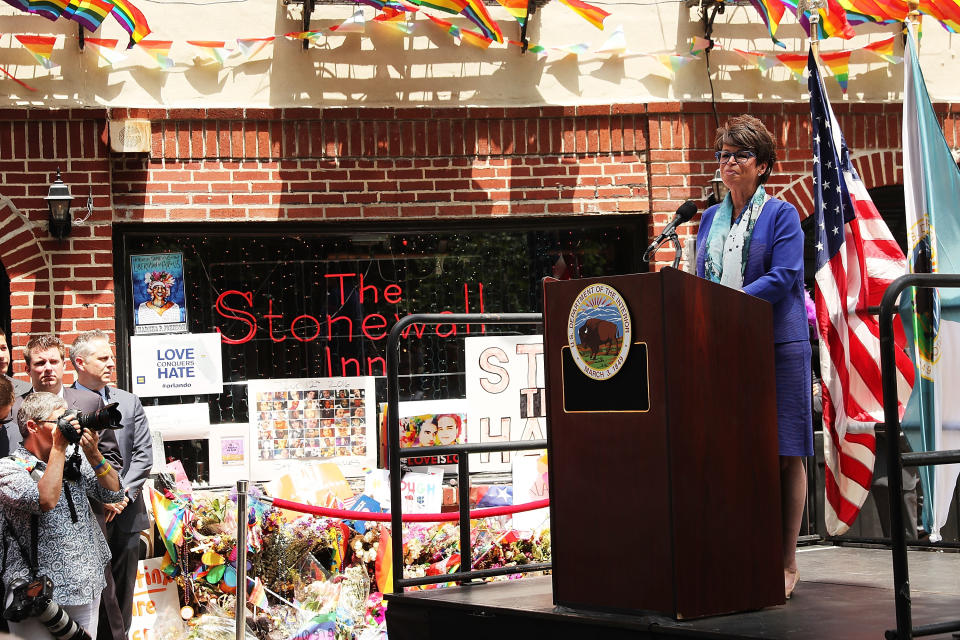'Why is June so gay?' and other Pride 101 facts you need to know
Welcome to Yahoo Lifestyle, Pride Edition, commemorating June — Pride Month — with a collection of stories celebrating the resilience of LGBTQ people, from celebs, including Adam Rippon and Karamo Brown, trans women finding their inner power through a unique beauty clinic, and queer youth finding vital support from their gay elders after aging out of the foster system. And so, as they shout in the streets: “We’re here, we’re queer — get used to it!”
My first Gay Pride, in New York City, just happened to coincide with the event’s 25-year anniversary. It was 1994, and the entire city exploded in wild jubilation during that last weekend in June.
Still, as I marched with my posse past the famed Stonewall Inn on Christopher Street in the West Village that Sunday — the site of the “gay liberation” kickoff of 1969 due to an uprising-turned-six-day-melee that became known as the Stonewall riots — I had just the slightest inkling of how its existence was inextricably linked to mine. From that day forward, as I got more enmeshed in the community, I quickly and hungrily learned — not only facts about the riots (more on that, below) and the beautiful reverberations, still being felt today, but also about something more nuanced: the resilient spirit that runs through the heart of LGBTQ culture.
Although my understanding grew (and keeps on growing) through personal experience, here’s what those new to the scene need to know about Pride…

How it all began
June 27, 1969, was not the first time in history that LGBTQ folks stood up for themselves (the gay-rights Mattachine Society, for example, was established in 1950). But it’s when the Stonewall riots — or uprising — began, lasting for nearly a full week and securing a place in history as the start of the modern gay rights movement. The flame was sparked by a police raid of the bar — just one of many that occurred regularly, as cops were cracking down on gay bars for operating without a state liquor license, which the bars did because the state wouldn’t provide licenses to places that catered to an LGBTQ crowd. That night’s raid, though, was the final straw for the nearly 200 patrons, and after 13 arrests — and, goes the story, a handcuffed lesbian (widely believed to be late West Village icon Stormé DeLarverie) being hit in the head with a billy club and then yelling for action — a gathering crowd rose up and resisted.

According to a recent Atlantic story, “The conflict over the next six days played out as a very gay variant of a classic New York street rebellion. It would see: fire hoses turned on people in the street, thrown barricades, gay cheerleaders chanting bawdy variants of New York City schoolgirl songs, Rockette-style kick lines in front of the police, the throwing of a firebomb into the bar, a police officer throwing his gun at the mob, cries of ‘occupy — take over, take over,’ ‘Fag power,’ ‘Liberate the bar!’, and ‘We’re the pink panthers!’, smashed windows, uprooted parking meters, thrown pennies, frightened policemen, angry policemen, arrested mafiosi, thrown cobblestones, thrown bottles, the singing of ‘We Shall Overcome’ in high camp fashion, and a drag queen hitting a police officer on the head with her purse.”
An account written at the time by gay journalist Dick Leitsch, according to David Carter’s Stonewall: The Riots That Sparked the Gay Revolution, noted the cultural importance of the bar to many displaced LGBTQ young adults at the time. “The Stonewall became ‘home’ to these kids. When it was raided, they fought for it. That, and the fact that they had nothing to lose other than the most tolerant and broadminded gay place in town, explains why the Stonewall riots were begun, led and spearheaded by ‘queens.’”

The anger of the swelling crowd soon gave way to an empowering rally, which was commemorated a year later with march and another rally — and every year since, with other anniversary events popping up in cities and towns across the country, mostly in June. (See a full list of Pride events in the U.S. and around the world here and here.)
Today’s legacy
Although the Stonewall itself remained closed until 1990 and struggled for years, it was renovated in 2007 and is now comprised of two buildings, becoming the first LGBTQ site in the country to be listed on the National Register of Historic Places, in 1999, and being named a National Historic Landmark in 2000. Then, in 2016, President Barack Obama declared the bar and its surrounding area (Christopher Street Park) the Stonewall National Monument, creating the first National Park Service segment dedicated to the gay rights movement.

“The Stonewall Uprising is considered by many to be the catalyst that launched the modern LGBT civil rights movement,” President Obama wrote in the proclamation. “From this place and time, building on the work of many before, the nation started the march — not yet finished — toward securing equality and respect for LGBT people.”
The Stonewall remains a powerful place for demonstration today; it’s the town square that crowds of LGBTQ New Yorkers are instinctively drawn to whenever big news happens, whether good — the Supreme Court’s 2015 decision to make marriage equality the law of the land, for example — or bad, as with the horrific Pulse nightclub massacre of the following year, after which crowds gathered to hold each other up with a candlelight vigil.
As for the NYC march — not a parade, stress its organizers (Heritage of Pride, producers of the event since 1984), who are determined to keep its political roots intact — it continues, hundreds of thousands strong, every year on the last Sunday in June, its final stretch passing by the Stonewall as jubilant crowds roar. Separate identity-based breakout events have become established civil-rights actions too — namely, the independently run Dyke March (this writer’s favorite Pride event), happening every Saturday before the Sunday march, with sister events in cities, including Philadelphia, San Francisco, and Chicago; and the Trans Rights March, happening in cities from Seattle to D.C.

In 2019, New York will be the site of World Pride, a biannual blowout from the organization InterPride; past events have taken over the streets in Rome, Jerusalem, London, Toronto, and Madrid.
More people seem to flock to the alternative events, feeling that the main Pride marches — now infiltrated with endless streams of corporate-sponsored floats — have become too commercial and soulless. It’s something that gay historian Martin Duberman warned against in a 2017 Queerty interview.
“I think the March this year needs to be, above all, political. Less frivolity and more anger,” he said. “Trump is no friend to the LGBTQ community and gay people need to make it clear that we regard ourselves as part of the Resistance. It isn’t clear now.”
For many queer people, that resistance is ever present, in the form of the resilience that runs deep, whether it’s June or not. We saw it recently with the incredible March for Our Lives, powered in part by an undercurrent of LGBTQ activism, particularly by one Emma Gonzalez. Earlier this year, Cynthia Nixon declared her candidacy for governor of New York at an event held within the Stonewall, packed with queer supporters despite a snowstorm that evening.
Yahoo Lifestyle will be celebrating LGBTQ resilience in many forms as we roll out features this month — through the personal stories of role models, including figure skater Adam Rippon, transgender model Munroe Bergdorf, and celebrity makeup artist Jonathan Fernandez; by introducing the world to an empowering transgender beauty clinic; and by reporting on the experiences of people who have gone through so-called gay conversion therapy, seeking U.S asylum, and experiencing turbulent childhoods marked by homelessness and foster care, only to come out on the other side, more powerful than ever before. Follow us every step of the way at Yahoo Lifestyle, Pride edition.
Read more from Yahoo Lifestyle:
Follow us on Instagram, Facebook, and Twitter for nonstop inspiration delivered fresh to your feed, every day.

